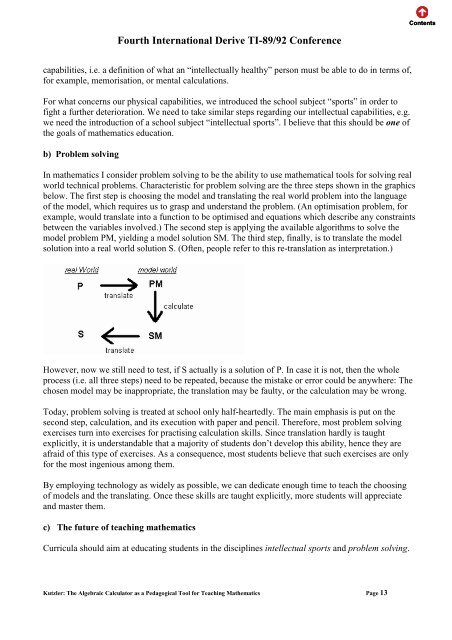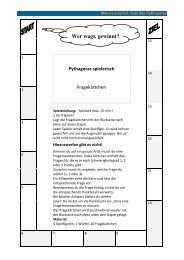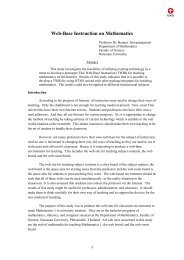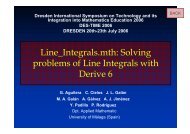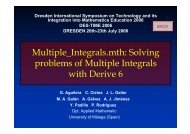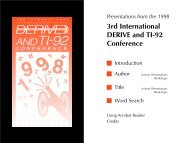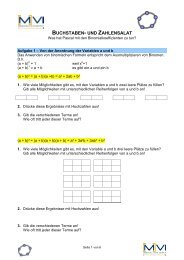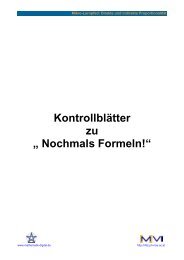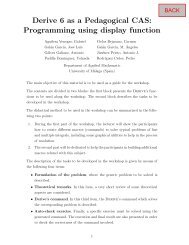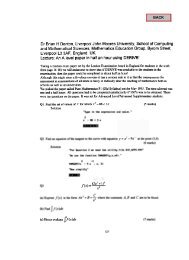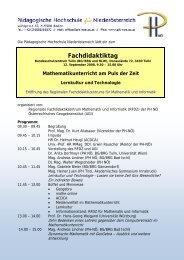The Algebraic Calculator as a Pedagogical Tool for Teaching ...
The Algebraic Calculator as a Pedagogical Tool for Teaching ...
The Algebraic Calculator as a Pedagogical Tool for Teaching ...
You also want an ePaper? Increase the reach of your titles
YUMPU automatically turns print PDFs into web optimized ePapers that Google loves.
Fourth International Derive TI-89/92 Conference<br />
capabilities, i.e. a definition of what an “intellectually healthy” person must be able to do in terms of,<br />
<strong>for</strong> example, memorisation, or mental calculations.<br />
For what concerns our physical capabilities, we introduced the school subject “sports” in order to<br />
fight a further deterioration. We need to take similar steps regarding our intellectual capabilities, e.g.<br />
we need the introduction of a school subject “intellectual sports”. I believe that this should be one of<br />
the goals of mathematics education.<br />
b) Problem solving<br />
In mathematics I consider problem solving to be the ability to use mathematical tools <strong>for</strong> solving real<br />
world technical problems. Characteristic <strong>for</strong> problem solving are the three steps shown in the graphics<br />
below. <strong>The</strong> first step is choosing the model and translating the real world problem into the language<br />
of the model, which requires us to gr<strong>as</strong>p and understand the problem. (An optimisation problem, <strong>for</strong><br />
example, would translate into a function to be optimised and equations which describe any constraints<br />
between the variables involved.) <strong>The</strong> second step is applying the available algorithms to solve the<br />
model problem PM, yielding a model solution SM. <strong>The</strong> third step, finally, is to translate the model<br />
solution into a real world solution S. (Often, people refer to this re-translation <strong>as</strong> interpretation.)<br />
However, now we still need to test, if S actually is a solution of P. In c<strong>as</strong>e it is not, then the whole<br />
process (i.e. all three steps) need to be repeated, because the mistake or error could be anywhere: <strong>The</strong><br />
chosen model may be inappropriate, the translation may be faulty, or the calculation may be wrong.<br />
Today, problem solving is treated at school only half-heartedly. <strong>The</strong> main emph<strong>as</strong>is is put on the<br />
second step, calculation, and its execution with paper and pencil. <strong>The</strong>re<strong>for</strong>e, most problem solving<br />
exercises turn into exercises <strong>for</strong> practising calculation skills. Since translation hardly is taught<br />
explicitly, it is understandable that a majority of students don’t develop this ability, hence they are<br />
afraid of this type of exercises. As a consequence, most students believe that such exercises are only<br />
<strong>for</strong> the most ingenious among them.<br />
By employing technology <strong>as</strong> widely <strong>as</strong> possible, we can dedicate enough time to teach the choosing<br />
of models and the translating. Once these skills are taught explicitly, more students will appreciate<br />
and m<strong>as</strong>ter them.<br />
c) <strong>The</strong> future of teaching mathematics<br />
Curricula should aim at educating students in the disciplines intellectual sports and problem solving.<br />
Kutzler: <strong>The</strong> <strong>Algebraic</strong> <strong>Calculator</strong> <strong>as</strong> a <strong>Pedagogical</strong> <strong>Tool</strong> <strong>for</strong> <strong>Teaching</strong> Mathematics Page 13


